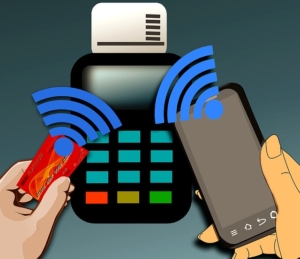In our final post of 2016, we’ve gathered a collection of expert predictions about the payments industry for 2017. The payments industry forecast is for competitive storms, heavy regulatory weather and further technology disruptions to say the least.
TheMSPhub looks at six Fintech disruptors in the payments space that are enabling users to take payments to the next level in terms of speed, convenience, efficiency and multichannel accessibility. PYMNTS.com posted an excellent roundup of B2B payment expert predictions for 2017 including regulations and faster payments initiatives, technological innovation in corporate payments and cash management. David Weiss, President of YapStone predicts many new opportunities to discover innovation in unlikely places in payments.
 Mike Galarza, CEO of Entryless, expects business to move away from monolithic banks in search of innovative new services. Michelle Tinsley, director of mobility and secure payment solutions at Intel identified three trends: the need to build value into new technology; cryptocurrencies the providing faster payments; and IoT and other devices enabling payments.
Mike Galarza, CEO of Entryless, expects business to move away from monolithic banks in search of innovative new services. Michelle Tinsley, director of mobility and secure payment solutions at Intel identified three trends: the need to build value into new technology; cryptocurrencies the providing faster payments; and IoT and other devices enabling payments.
Ernst & Young’s Fintech Adoption Index indicates the traditional financial services sector is at serious risk of disruption. Thomas Bull, director of Fintech at EY, noted 15.5% of 10,000 digitally active consumers surveyed used at least two fintech products in the previous six months. The report said $12 billion has been invested into fintech companies in 2015.
 André Stoorvogel of Rambus Bell ID predicted that IoT and “invisible payments” will shape the payments industry in 2017. Gijs op de Weegh, COO of Payvision highlighted the contrast between consumers who reached out to shop internationally while merchants pulled back from reaching out to these new digital consumers. George Kikvadze, vice chairman of major Bitcoin mining and Blockchain technology company Bitfury expects 2017 to see mainstream acceptance of new cryptocurrencies.
André Stoorvogel of Rambus Bell ID predicted that IoT and “invisible payments” will shape the payments industry in 2017. Gijs op de Weegh, COO of Payvision highlighted the contrast between consumers who reached out to shop internationally while merchants pulled back from reaching out to these new digital consumers. George Kikvadze, vice chairman of major Bitcoin mining and Blockchain technology company Bitfury expects 2017 to see mainstream acceptance of new cryptocurrencies.
Jeremy Peruski from ICR says the US can learn a lot from China where credit cards have really never taken hold compared with mobile payments and payment apps. In India, Tracxn reported fintech investments in 2016 were $484.79 million, driven by lending and the impact of demonetization on the payments sector.
Inc.com featured eight payment trends that could hurt small business. Certify expects more automation and a lower barrier to entry to provide opportunities for new entries in the business travel and expense sector.
6 Fintech Players Changing the Face of Global Payments
 The onset of the digital revolution has facilitated diversification, fragmentation and personalisation of spaces as diverse as media, travel and communications. Through the emergence and popularization of fintech platforms, this process is reshaping the payments space. The emergence of fintech disruptors in the payments space is enabling users to take payments to the next level in terms of speed, convenience, efficiency and multichannel. To add to this, the number and type of fintech players is growing and bringing with them new tools and solutions which are overhauling the payments world as we know it.
The onset of the digital revolution has facilitated diversification, fragmentation and personalisation of spaces as diverse as media, travel and communications. Through the emergence and popularization of fintech platforms, this process is reshaping the payments space. The emergence of fintech disruptors in the payments space is enabling users to take payments to the next level in terms of speed, convenience, efficiency and multichannel. To add to this, the number and type of fintech players is growing and bringing with them new tools and solutions which are overhauling the payments world as we know it.
As a result, this is no longer a case of faster payment methods but a complete overturning of the idea of ‘value’ and how we transfer it between different entities. In this post, we’ll talk about 6 fintech players to watch out for in four main categories. First, we’ll look at retail-focused fintechs. Second, we’ll examine an employer payroll focused start up. Third, we’ll focus on an online micropayments player. Finally, we’ll look at the fintechs firms expertly taking on the field of international transfers. Via themsphub.com
B2B Payments Players Offer 2017 Predictions
 Analysts continue to flesh out their predictions for payments and FinTech in 2017, but one can never truly know the exact direction an industry will take. The B2B payments space is positioned to go in multiple directions as regulations and faster payments initiatives offer new opportunities in speed and efficiency, as technological innovation improves corporate payments and cash management and as market conditions, like globalization, introduce new demands and pressures for businesses and their financial services providers.
Analysts continue to flesh out their predictions for payments and FinTech in 2017, but one can never truly know the exact direction an industry will take. The B2B payments space is positioned to go in multiple directions as regulations and faster payments initiatives offer new opportunities in speed and efficiency, as technological innovation improves corporate payments and cash management and as market conditions, like globalization, introduce new demands and pressures for businesses and their financial services providers.
Executives from Payoneer, NCR, FTV Capital and Ingo Money touch upon these trends as they tell PYMNTS their own visions for B2B payments next year. Find out what they had to say below. Via pymnts.com
Payments Execs Share Industry Advice
 Over the years, we’ve heard from many payments stakeholders, and as 2017 approaches, we’ve gathered some of the advice we think everyone should keep top of mind. “It’s extraordinarily difficult to build a payments company in this market environment … I would advise seeking meaningful partnerships that accelerate and de-risk the business plan. We look at Money20/20 and imagine how many of those companies will have thriving businesses three to five years from now.
Over the years, we’ve heard from many payments stakeholders, and as 2017 approaches, we’ve gathered some of the advice we think everyone should keep top of mind. “It’s extraordinarily difficult to build a payments company in this market environment … I would advise seeking meaningful partnerships that accelerate and de-risk the business plan. We look at Money20/20 and imagine how many of those companies will have thriving businesses three to five years from now.
David Weiss, President of YapStone
The payments space is rapidly expanding, and as new entrants continue join the fold, Weiss noted that there’s plenty of opportunity to discover innovation in unlikely places. He told PYMNTS that it’s necessary to search both internally and externally, across a growing pool of partners and constituencies, when carving out the path to innovation. Via pymnts.com
Entryless: Payments 2016: The Year of Businesses No Longer Relying on Banks
 PYMNTS consulted 21 payments executives from across the industry to share their insights on the biggest takeaways from 2016 as part of the “Payments 2016, The Year Of…” eBook. We posed the same question to each executive:
PYMNTS consulted 21 payments executives from across the industry to share their insights on the biggest takeaways from 2016 as part of the “Payments 2016, The Year Of…” eBook. We posed the same question to each executive:
If you had to answer the question, Payments was the year of …, how would you answer, and how does your answer change your world — and the world of payments, more broadly? Here is the response from Mike Galarza, founder and CEO of Entryless…
Payments 2016: The Year Of Businesses No Longer Relying on Banks
For years, consumers have reaped the benefits of technology in their personal banking. Virtually every consumer financial task has been automated, making everything faster, easier and more efficient. Via pymnts.com
Intel: Payments 2016: The Year of Major Shifts in Payments
 Commerce paradigms are shifting, but with new technologies and quickening innovation, the question remains if real value is still being delivered. Michelle Tinsley, director of mobility and secure payment solutions, Internet of Things group, retail solutions division at Intel, shares why the industry can’t forget about value while speeding down the path to transforming payments.
Commerce paradigms are shifting, but with new technologies and quickening innovation, the question remains if real value is still being delivered. Michelle Tinsley, director of mobility and secure payment solutions, Internet of Things group, retail solutions division at Intel, shares why the industry can’t forget about value while speeding down the path to transforming payments.
Emerging Technologies Are Finding New Ground in Payments, Facilitating New Commerce Paradigms
Recent technology advancements, particularly in the Internet of Things (IoT), are driving major shifts in payments. These innovations aren’t necessarily new, but they’re finding new ways to change commerce. Here are three key shifts we’ve seen in 2016. Via pymnts.com
Top Global Payments & Transfer read of 2016: Ernst and Young: Fintech is Not Just About Tech
 15.5% of digitally active consumers have used at least two fintech products within the last six months. This finding emerged from the survey that was conducted by Ernst and Young (EY), where more than 10,000 people in the UK, Australia, Canada, Hong Kong, Singapore and the US were questioned about their current and potential future use of fintech. The traditional financial services sector is at risk of disruption and EY’s Fintech Adoption Index is evidence of this occurring worldwide.
15.5% of digitally active consumers have used at least two fintech products within the last six months. This finding emerged from the survey that was conducted by Ernst and Young (EY), where more than 10,000 people in the UK, Australia, Canada, Hong Kong, Singapore and the US were questioned about their current and potential future use of fintech. The traditional financial services sector is at risk of disruption and EY’s Fintech Adoption Index is evidence of this occurring worldwide.
bobsguide spoke to Thomas Bull, director of fintech at EY, about why there has been an explosion of new technology-led entrants, which industries have boomed and who is adopting fintech. As disruption increases, legacy players have to learn from fintechs about how to provide a convenient service and harness technology effectively. Bull states that EY defines “fintechs as firms that are combining innovative business models and technology to enable, enhance and disrupt financial services.”
2015 saw $12 billion being invested into fintech companies, according to the EY Global Financial Service Institute report called “Fintech is gaining traction and young, high-income users are the early adopters”. The report also highlighted that the best fintechs are always the companies that take the customers seriously. “The most promising fintech companies have a laser-like specific customer proposition – generally one that is poorly served, if at all, by traditional financial services companies – and serve up a seamless and intuitive user experience,” the report read. Via bobsguide.com
2017 – introducing mobile payments 2.0
 Difficult Second Album, Sophomore Slump, Second Year Blues – it’s not easy maintaining success. Happily, says André Stoorvogel of Rambus Bell ID, following its breakout year in 2015, the mobile payments industry has seen continued innovation and growth in 2016. So, as we approach the end of the year, what are the key trends and technologies that will shape the industry into 2017?
Difficult Second Album, Sophomore Slump, Second Year Blues – it’s not easy maintaining success. Happily, says André Stoorvogel of Rambus Bell ID, following its breakout year in 2015, the mobile payments industry has seen continued innovation and growth in 2016. So, as we approach the end of the year, what are the key trends and technologies that will shape the industry into 2017?
IoT and ‘invisible payments’
Providing the consumer with a truly frictionless experience is the holy grail for the payments industry. This has already been achieved in-app with platforms such as Uber, but has yet to be translated in-store.
In the IoT era, however, we are moving ever closer to delivering a seamless in-store experience. Beacons, geolocation, computer vision and biometric technologies are being combined to deliver a frictionless experience. Via vanillaplus.com
Global Uncertainty Weighs on Cross-Border E-Commerce: Report
 An uncertain geopolitical and global economic environment made e-commerce merchants a bit less daring in 2016 when looking outside their own borders, according to the results of new research from CardNotPresent.com and Payvision. Each year since the survey began in 2013, a growing number of online merchants signaled their willingness to sell internationally and the belief that such activity was profitable. In 2016, however, uncertainty in Europe around the U.K.’s decision to leave the EU and an economic slowdown in China—the world’s largest and fastest-growing e-commerce market—resulted in flat growth in those categories. Given his unpredictability and protectionist campaign rhetoric, the election of Donald Trump as president of the United States in November will have only exacerbated merchants’ concerns about cross-border e-commerce.
An uncertain geopolitical and global economic environment made e-commerce merchants a bit less daring in 2016 when looking outside their own borders, according to the results of new research from CardNotPresent.com and Payvision. Each year since the survey began in 2013, a growing number of online merchants signaled their willingness to sell internationally and the belief that such activity was profitable. In 2016, however, uncertainty in Europe around the U.K.’s decision to leave the EU and an economic slowdown in China—the world’s largest and fastest-growing e-commerce market—resulted in flat growth in those categories. Given his unpredictability and protectionist campaign rhetoric, the election of Donald Trump as president of the United States in November will have only exacerbated merchants’ concerns about cross-border e-commerce.
The result, according to the annual Key Business Drivers and Opportunities in Cross-Border E-commerce, is that merchants are concerned and did not expand their cross-border activities at the rate they had in previous years. Instead of targeting emerging markets, merchants concentrated more this year on consumers in countries with which they shared language and culture, which they considered less risky to sell to. Consumers, on the other hand, continue to look for the best products and the best price, no matter where in the world that takes them, according to Gijs op de Weegh, COO of Payvision.
“The omnichannel consumer mindset is quite the opposite of merchants’,” op de Weegh said. “Consider Alibaba’s Singles’ Day, the largest revenue-driving e-commerce day in the world. This year, it generated nearly $18 billion in sales in China, and almost a third of this was driven by foreign purchases. With a maturing set of millennial consumers, with more and more disposable income, the modern shopper is no longer domestic or cross-border, neither mobile nor in-store, they are everywhere.” Via cardnotpresent.com
Bitfury Executive Predicts: In 2017, Bitcoin’s Blockchain will Likely be at Helm of Financial Revolution
 George Kikvadze, vice chairman of major Bitcoin mining and Blockchain technology company Bitfury, laid out his expectations and predictions for 2017 regarding the development of the Bitcoin industry, the community and, most importantly, the Bitcoin network.
George Kikvadze, vice chairman of major Bitcoin mining and Blockchain technology company Bitfury, laid out his expectations and predictions for 2017 regarding the development of the Bitcoin industry, the community and, most importantly, the Bitcoin network.
“Most of the Bitcoin community has assumed the approval of the first Bitcoin ETF will be a positive for the price of Bitcoin. That’s because it will add to the legitimacy of the digital currency in addition to providing a new avenue for people to invest in Bitcoin.”
More importantly, Bitcoin startups have also begun to attract high-profile investors within the tech industry, which correlates with the decline of Blockchain hype and Blockchain startups. For instance, innovative Bitcoin startup Coins, which provides robust, efficient and highly liquid Bitcoin infrastructures in remittance-heavy countries like the Philippines, Malaysia and Thailand, secured a $5 million investment in a Series A funding round led by Accion Frontier Inclusion. Via cointelegraph.com
The Biggest Tech Trends From China to Watch Out for in 2017
 Financial products aimed at an emerging and growing middle class are on the rise and are expected to grow amid burgeoning demand. China’s consumers have skipped many stages in their technological progression, bypassing aging Western technology in favor of new trends, said Jeremy Peruski, from ICR, a consulting firm.
Financial products aimed at an emerging and growing middle class are on the rise and are expected to grow amid burgeoning demand. China’s consumers have skipped many stages in their technological progression, bypassing aging Western technology in favor of new trends, said Jeremy Peruski, from ICR, a consulting firm.
“I really do believe that China is becoming a global hub when looking at global technology and they historically have led with creating financial products,” Peruski said. “This will only continue to accelerate because we see China skipping growth patterns we saw in the U.S.”
Credit cards have never taken hold, with most customers opting instead to use their phones and payment apps such as Alibaba’s payment system, Alipay, and WeChat. An Ernst & Young report found that 40 percent of consumers in China now use new payment methods. Via forbes.com
Fintech: no more the new kid on the block
 Year 2016 was not as glamorous as 2015 was for fintech in terms of interest from investors. According to start-up data analytics provider Tracxn, investments in 2016 were $484.79 million, compared with $1.18 billion in 2015. One of the reasons is that the 2015 numbers include money raised by Paytm in 2015. The number of companies founded was also lower—186 in 2016 as against 390 in 2015, according to Tracxn data.
Year 2016 was not as glamorous as 2015 was for fintech in terms of interest from investors. According to start-up data analytics provider Tracxn, investments in 2016 were $484.79 million, compared with $1.18 billion in 2015. One of the reasons is that the 2015 numbers include money raised by Paytm in 2015. The number of companies founded was also lower—186 in 2016 as against 390 in 2015, according to Tracxn data.
Lending was the emerging theme in fintech. The segment received about $215 million in funding and 57 new companies entering the space. However, payments continued to be the flavour of the year thanks to demonetization. The most active investor in fintech was Sequoia Capital, followed by Accel Partner, according to a Tracxn report. The year also saw some acquisitions in fintech. For instance, Naspers’ PayU, a digital payments provider, acquired Citrus Pay, while Flipkart acquired payment startup PhonePe.
Here’s a look at some of the major themes that played out in fintech and how they fared in 2016. Via livemint.com
8 Payment Trends That Are Hurting Your Business
 The way that customers pay businesses is constantly evolving. Instead of paying with paper, like cash and checks, businesses are expected to accept a variety of payment methods ranging from credit cards to digital payments. While these are meant to benefit both the business and the customer, payment trends can sometimes harm your business if you aren’t educated, prepared, or knowledgeable in these emerging payment solutions.
The way that customers pay businesses is constantly evolving. Instead of paying with paper, like cash and checks, businesses are expected to accept a variety of payment methods ranging from credit cards to digital payments. While these are meant to benefit both the business and the customer, payment trends can sometimes harm your business if you aren’t educated, prepared, or knowledgeable in these emerging payment solutions.
To help your business get-off on the right foot in 2017, here are 8 payment trends that could hurt your business. Via inc.com
Certify Says More Robots in T&E Next Year
 If history is any indication, corporate travel and entertainment expense management technology is poised to drive even greater operational efficiency across the enterprise in the year ahead. Here are two growing trends we can expect to see more of in 2017.
If history is any indication, corporate travel and entertainment expense management technology is poised to drive even greater operational efficiency across the enterprise in the year ahead. Here are two growing trends we can expect to see more of in 2017.
More robots (and true automation) will rise
The benefits of automation are undeniable, including the efficiencies that come from integrating accounting, human resources and other corporate systems. Still, several leading expense reporting solutions today use a mix of computer automation and human facilitators to parse receipt data, advance workflows and manage other critical processes. These hybrid systems often lack the immediacy of true automation and reintroduce the potential for human error — a big reason why many turn to automation in the first place. So, that’s just not going to work anymore. In 2017, we’ll see demand grow for automation technology that virtually eliminates the need for human intervention in processing expense reports and receipt data. Business travelers and accounting professionals will always have an essential role, and improvements in true automation will allow them to focus on what they do best. Via pymnts.com
2017 – The year of payments industry disruption
With all these expert predictions, one thing is clear. 2017 will be the year of disruption in fintech and the payments industry. That’s not a bad thing because it creates opportunities. It does point to the importance of staying informed and ahead of the competition.
Our goal at PaymentsNEXT is to provide you with real business intelligence that can help you remain competitive, be more agile and profitable in serving your customers, and help you keep an eye on what’s next in the payments industry. Join our list of subscribers and get news you can use every Monday-Wednesday-Friday morning in your inbox.
Here’s to a successful and profitable 2017!








LET’S CONNECT